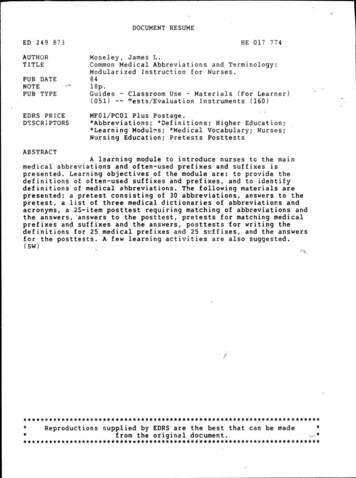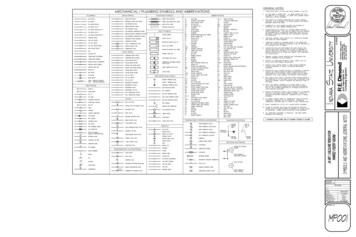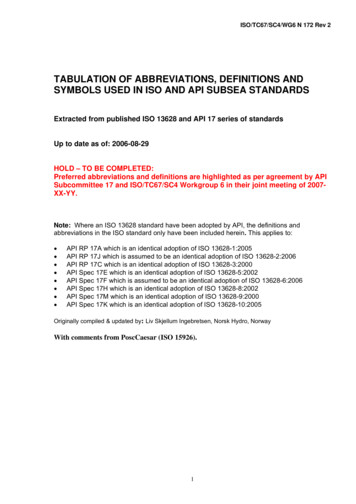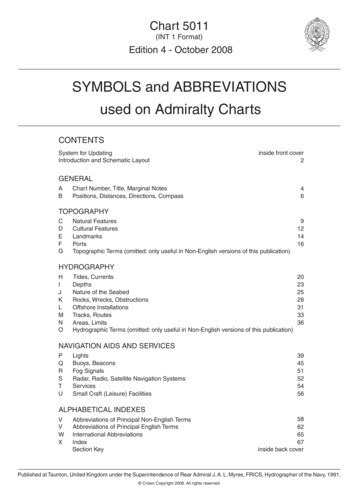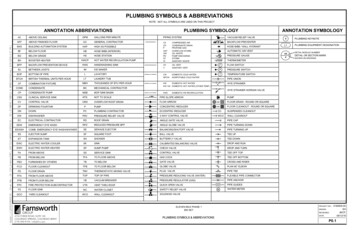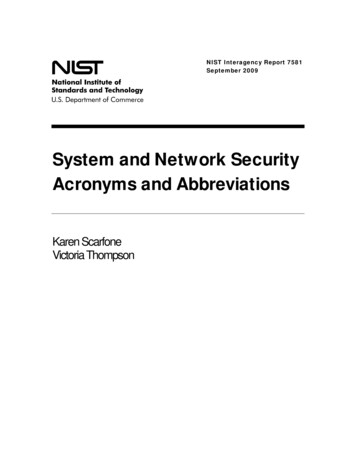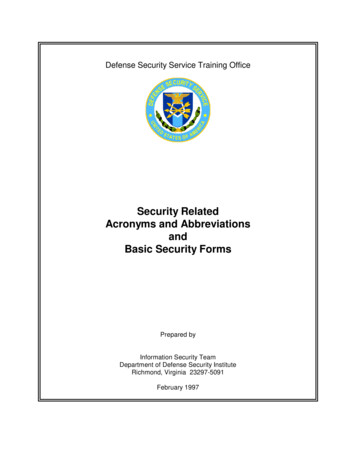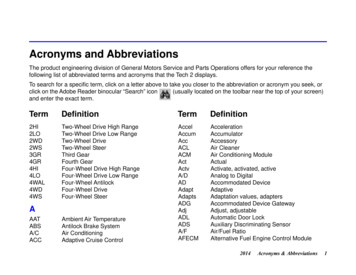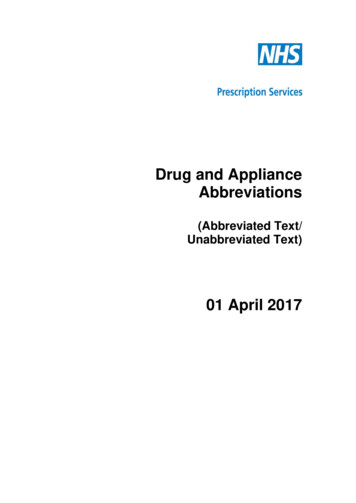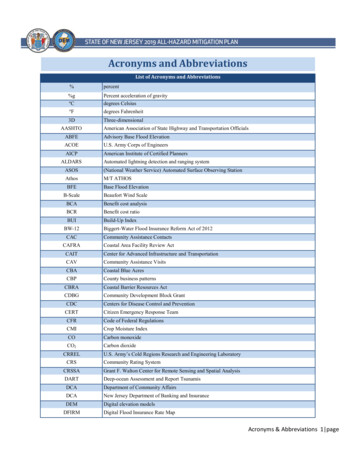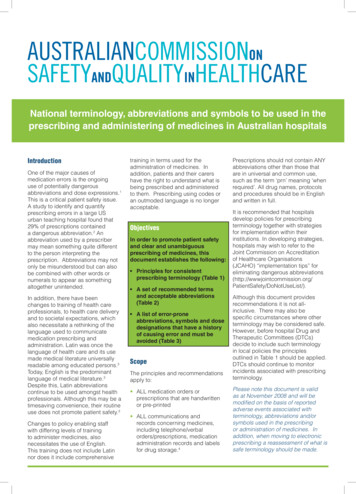
Transcription
National terminology, abbreviations and symbols to be used in theprescribing and administering of edicines in AustralianIntroductionOne of the major causes ofmedication errors is the ongoinguse of potentially dangerousabbreviations and dose expressions.1This is a critical patient safety issue.A study to identify and quantifyprescribing errors in a large USurban teaching hospital found that29% of prescriptions containeda dangerous abbreviation.2 Anabbreviation used by a prescribermay mean something quite differentto the person interpreting theprescription. Abbreviations may notonly be misunderstood but can alsobe combined with other words ornumerals to appear as somethingaltogether unintended.In addition, there have beenchanges to training of health careprofessionals, to health care deliveryand to societal expectations, whichalso necessitate a rethinking of thelanguage used to communicatemedication prescribing andadministration. Latin was once thelanguage of health care and its usemade medical literature universallyreadable among educated persons.3Today, English is the predominantlanguage of medical literature.3Despite this, Latin abbreviationscontinue to be used amongst healthprofessionals. Although this may be atimesaving convenience, their routineuse does not promote patient safety.3Changes to policy enabling staffwith differing levels of trainingto administer medicines, alsonecessitates the use of English.This training does not include Latinnor does it include comprehensivetraining in terms used for theadministration of medicines. Inaddition, patients and their carershave the right to understand what isbeing prescribed and administeredto them. Prescribing using codes oran outmoded language is no longeracceptable.ObjectivesIn order to promote patient safetyand clear and unambiguousprescribing of medicines, thisdocument establishes the following: Principles for consistentprescribing terminology (Table 1) A set of recommended termsand acceptable abbreviations(Table 2) A list of error-proneabbreviations, symbols and dosedesignations that have a historyof causing error and must beavoided (Table 3)ScopeThe principles and recommendationsapply to: ALL medication orders orprescriptions that are handwrittenor pre-printed ALL communications andrecords concerning medicines,including telephone/verbalorders/prescriptions, medicationadministration records and labelsfor drug storage.4Prescriptions should not contain ANYabbreviations other than those thatare in universal and common use,such as the term ‘prn’ meaning ‘whenrequired’. All drug names, protocolsand procedures should be in Englishand written in full.It is recommended that hospitalsdevelop policies for prescribingterminology together with strategiesfor implementation within theirinstitutions. In developing strategies,hospitals may wish to refer to theJoint Commission on Accreditationof Healthcare Organisations(JCAHO) “implementation tips” foreliminating dangerous tSafety/DoNotUseList/).Although this document providesrecommendations it is not allinclusive. There may also bespecific circumstances where otherterminology may be considered safe.However, before hospital Drug andTherapeutic Committees (DTCs)decide to include such terminologyin local policies the principlesoutlined in Table 1 should be applied.DTCs should continue to monitorincidents associated with prescribingterminology.Please note this document is validas at November 2008 and will bemodified on the basis of reportedadverse events associated withterminology, abbreviations and/orsymbols used in the prescribingor administration of medicines. Inaddition, when moving to electronicprescribing a reassessment of what issafe terminology should be made.
Table 1: Principles for consistent prescribing terminology1.Use plain English - avoid jargon2.Write in full - avoid using abbreviations wherever possible, including Latin abbreviations3.Print all text - especially drug names4.Use generic drug namesException may be made for combination products, but only if the trade name adequately identifies themedication being prescribed. For example, if trade names are used, combination products containing apenicillin (eg Augmentin , Timentin ) may not be identified as penicillins.Exception may also be made where significant bioavailability issues exist, for example cyclosporin,amphotericin5.Write drug names in full. NEVER abbreviate any drug nameSome examples of unacceptable drug name abbreviations are: G-CSF (use filgrastim or lenograstim orpegfilgrastim), AZT (use zidovudine), 5-FU (use fluorouracil), DTIC (use dacarbazine), EPO (use epoetin), TAC(use triamcinolone)Exception may be made for modified release productsFor slow release, controlled release, continuous release or other modified release products, the descriptionused in the trade name to denote the release characteristics should be included with the generic drug name, forexample tramadol SR, carbamazepine CRFor multi-drug protocols, prescribe each drug in full and do not use acronyms, for example do notprescribe chemotherapy as ‘CHOP’. Prescribe each drug separately6.Do not use chemical names/symbols, for example HCl (hydrochloric acid or hydrochloride) may be mistakenfor KCl (potassium chloride)Do not include the salt of the chemical unless it is clinically significant, for example mycophenolatemofetil or mycophenolate sodium. Where a salt is part of the name it should follow the drug name and notprecede it7.Dose Use words or Hindu-Arabic numbers, ie 1, 2, 3 etcDo not use Roman numerals, ie do not use ii for two, iii for three, v for five etc Use metric units, such as gram or mLDo not use apothecary units, such as minims or drams Use a leading zero in front of a decimal point for a dose less than 1, for example use 0.5 not .5Do not use trailing zeros, for example use 5 not 5.0 For oral liquid preparations, express dose in weight as well as volume, for example in the case ofmorphine oral solution (5mg/mL) prescribe the dose in mg and confirm the volume in brackets: eg 10mg(2mL) Express dosage frequency unambiguously, for example use ‘three times a week’ not ‘three times weekly’as the latter could be confused as ‘every three weeks’8. Avoid fractions, for example- 1/7 could be interpreted as ‘for one day’, ‘once daily’, ‘for one week’ or ‘once weekly’- 1/2 could be interpreted as ‘half’ or as ‘one to two’9.Do not use symbols10. Avoid acronyms or abbreviations for medical terms and procedure names on orders or prescriptions,for example avoid EBM meaning ‘expressed breast milk’2
TABLE 2: Acceptable terms and abbreviationsThe following table lists the terms and abbreviations that are commonly used and understood and therefore considered acceptablefor use. Where there is more than one acceptable term the preferred term is shown first in the right hand column.Intended meaningAcceptable Terms or AbbreviationsDose Frequency or Timing(in the) morningmorning, mane(at) middaymidday(at) nightnight, noctetwice a daybdthree times a daytdsfour times a dayqidevery 4 hoursevery 4 hrs, 4 hourly, 4 hrlyevery 6 hoursevery 6 hrs, 6 hourly, 6 hrlyevery 8 hoursevery 8 hrs, 8 hourly, 8 hrlyonce a weekonce a week and specify the day in full, eg, once a week onTuesdaysthree times a weekthree times a week and specify the exact days in full, eg threetimes a week on Mondays, Wednesdays and Saturdayswhen requiredprnimmediatelystatbefore foodbefore foodafter foodafter foodwith foodwith foodRoute of administrationepiduralepiduralinhale, inhalationinhale, so-gastricNGoralPOpercutaneous enteral gastrostomyPEGper vaginaPVper rectumPRperipherally inserted central sublingtopicaltopical3
TABLE 2: Acceptable terms and abbreviations (continued)The following table lists the terms and abbreviations that are commonly used and understood and therefore considered acceptablefor use. Where there is more than one acceptable term the preferred term is shown first in the right hand column.Intended meaningAcceptable Terms or AbbreviationsUnits of Measure and Concentrationgram(s)gInternational unit(s)International itre(s)mLmicrogram(s)microgram, microgpercentage%millimolemmolDose Forms4capsulecapcreamcreamear dropsear dropsear ointmentear ointmenteye dropseye dropseye ointmenteye ointmentinjectioninjmetered dose inhalermetered dose inhaler, inhaler, MDImixturemixtureointmentointment, blet, tabpatient controlled analgesiaPCA
TABLE 3: Error-prone abbreviations, symbols and dosedesignations to be avoided(Adapted from the Institute of Safe Medication Practices [ISMP] list of the same name4, with permission from ISMP)Error-proneAbbreviationIntended MeaningWhy?4What should be used84µg, mcg or ugmicrogramMistaken as ‘mg’microgramBID or bidtwice dailyMistaken as ‘tid’ (three times daily)bdBT or btbedtimeMistaken as ‘BID’ (twice daily)bedtimecccubic centimetresMistaken as ‘u’ (units)mLD/Cdischarge or discontinuePremature discontinuation of medications if discharge‘discharge’ orintended‘discontinue’ whicheverMistaken for ‘ear’ when ‘eye’ intended or for ‘eye’ when‘eye’ or ‘ear’ and specify‘ear’ intendedwhether ‘left’, ‘right’ oris intendede or Eear or eye‘both’gtt or guttedropsLatin abbreviation meaning ‘drops’, not universally‘drops’ or ‘eye drops’understood.whichever is intendedHShalf-strengthMistaken as bedtime‘half-strength’ orhsat bedtime, hours of sleepMistaken as half-strength‘bedtime’ whichever isIJinjectionMistaken as ‘IV’ or ‘intrajugular’injectionINintranasalMistaken as ‘IM’or ‘IV’intranasalITintrathecalMistaken as IntravenousintrathecalintendedIUInternational unitsMistaken as ‘IV’ (Intravenous) or ‘10’ (ten)International unitsMmorningMistaken for ‘n’ (night)morningNnightMistaken for ‘m’ (morning)nightOc or Occeye ointmentMistaken for eye dropseye ointmentmistmixtureLatin abbreviation, not universally understoodmixtureo.d. or ODonce dailyMistaken as ‘right eye’ (OD-oculus dexter), leading to‘daily’, preferablyoral liquid medications administered in the eye. Canspecifying the time of thealso be mistaken for BD (twice daily)day, eg ‘morning’, ‘midday’, ‘at night’OJorange juiceMistaken as ‘OD’ or ‘OS’ (right or left eye); drugs meantorange juiceto be diluted in orange juice may be given in the eyeOWonce a weekNot universally understoodonce a weekp/fper fortnightNot universally understoodevery two weeks, perfortnightqd or QDevery dayMistaken as ‘Qid’, especially if the period after the ‘q’ ordailypulvpowderLatin abbreviation, not universally understoodpowderQhsnightly at bedtimeMistaken as ‘qhr’ or every hour‘night’,Qhevery hourNot universally understood‘hourly’,the tail of the ‘q’ is misunderstood as an ‘i’‘daily at bedtime’‘every hour’qod or QODevery other dayMistaken as ‘qd’ (daily) or ‘qid’ (four times daily)‘every second day’,‘on alternate days’Q6PM etcevery evening at 6 pmMistaken as every six hours‘6pm daily’,‘every night at 6pm’,‘every day at 6 pm’5
TABLE 3: Error-prone abbreviations, symbols and dosedesignations to be avoided (continued)(Adapted from the Institute of Safe Medication Practices [ISMP] list of the same name4, with permission from ISMP)Error-proneAbbreviationIntended MeaningWhy?What should be used84SCsubcutaneousMistaken as ‘SL’ (Sublingual)‘subcut’, ‘subcutaneous’SL or S/LsublingualMistaken as ‘SC’ (Subcutaneous)‘subling’, ‘under thetongue’Sssliding scale (insulin) orMistaken as ‘55’‘sliding scale’ or ‘half’half (apothecary)SSRI or SSIwhichever is intendedsliding scale regular insulinMistaken as selective serotonin reuptake inhibitor;sliding scale insulinor sliding scale insulinMistaken as Strong Solution of Iodine (Lugols)TIDthree times a dayMistaken as ‘bd’tdsTIWthree times a weekMistaken as ‘three times daily’‘three times a week’and specify exact daysin full, for example ‘onMondays, Wednesdaysand Saturdays’i/Done dailyMistaken as ‘tid’one dailyU or uunitMistaken as the numbers ‘0’ or ‘4’, causing a 10-foldunitoverdose or greater (eg 4U seen as ‘40’ or 4u seen as ‘44’).Mistaken as ‘cc’ so dose given as a volume instead ofunits (eg 4u seen as 4 cc)ungointmentError-pronefrequencyand dosageabbreviationsLatin abbreviation, not universally understoodIntended MeaningWhy?ointmentWhat should be used86/244every six hoursMistaken as ‘six times a day’‘every 6 hrs’,‘6 hourly’, ‘6 hrly’1/7for one dayMistaken as ‘for one week’for one day only1/2halfMistaken as ‘one or two’halfi, ii,iii,iv (Roman1,2,3,4 etcnumerals)6Hindu-Arabic numbers,1,2,3,4 etc or words
TABLE 3: Error-prone abbreviations, symbols and dosedesignations to be avoided (continued)(Adapted from the Institute of Safe Medication Practices [ISMP] list of the same name4, with permission from ISMP)Error-pronedosedesignationsand otherinformationIntended meaningWhy?What should be used8Trailing zero after41mgMistaken as 10mg if the decimal point is not seenDo not use trailing zerosdecimal pointfor doses expressed in(eg 1.0mg)whole numbersNo leading zero0.5mgMistaken as 5mg if the decimal point is not seenUse zero before abefore a decimaldecimal point whenpoint (eg .5mg)the dose is less than awhole unitLarge doses100,000 units100000 has been mistaken as 10,000, or 1,000,000;For figures above 100without properly1,000,0001000000 has been mistaken as 100,000use words to expressplaced commasintent eg, one thousand,(eg 100000units,one million, six million1000000 units)etc. Otherwise usecommas for dosingunits at or above 1,00010 etcone million6Not universally understoodUse one million or1,000,000Error-pronesymbolsIntended MeaningWhy?What should be used84X3dfor three daysMistaken as ‘3 doses’for three days or greater than or less thanMistaken or used as the opposite of intended; ‘ 10’‘greater than
drug name abbreviations are: G-CSF (use filgrastim or lenograstim or pegfilgrastim), AZT (use zidovudine), 5-FU (use fluorouracil), DTIC (use dacarbazine), EPO
